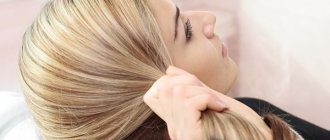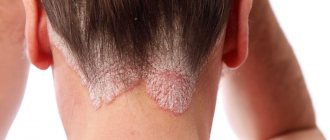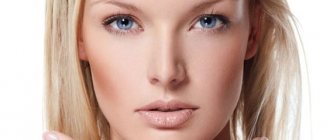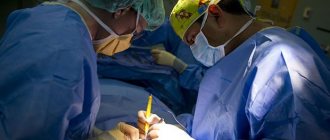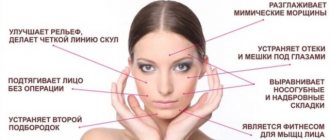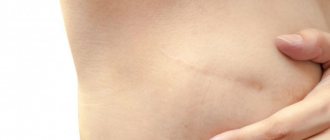What it is?
In cosmetology, the term hair plasmolifting refers to the injection of microscopic doses of one’s own plasma into the scalp.
Autoplasma is obtained by centrifugation from the patient’s previously taken venous blood. In the plasma separated from the blood, the content of platelets increases by at least 10 times, which is what allows the introduction of biomaterial to activate the restoration of cells and tissues.
Carrying out plasmolifting transfers hair follicles that are in the resting stage into the growth phase, due to which the density of the strands increases and their growth improves.
But this is not the only effect of the procedure - under the influence of autoplasma, local immunity improves, microcirculation and the functioning of the sebaceous glands are normalized, the activity of pathogenic microorganisms is suppressed, and hair follicles begin to receive more nutrients, microelements and vitamins.
Types of injections for plasma therapy
There are several types of plasma therapy.
Conventionally, they are divided into 3 groups:
- Russian – “classical” method developed by Russian surgeons to speed up recovery processes after surgery. Subsequently he switched to cosmetology. The injection consists of the patient's purified blood plasma;
- Swiss (PRP - plasma therapy) – an improved method that uses membrane tubes and a special frequency centrifuge. In Russia, Swiss plasma therapy appeared only in recent years, but has managed to establish itself as an effective method of combating scalp problems. Platelets are added to the finished injection for a deeper effect on the problem area of the skin;
- Spanish (Endoret) – a modern method of activating the patient’s platelets for rejuvenation and tissue restoration. The drug is activated only in the patient's skin when a special solution is added.
Indications for use
A course of plasma lifting is prescribed by a cosmetologist or trichologist after assessing the condition of the patient’s hair. The effectiveness of using the technique is determined by how correctly the doctor has identified the main problem of the deterioration of the condition of the curls - plasma therapy does not always give the expected result.
General indications for the procedure include:
- Increased hair fragility, excessive dryness;
- Excessive hair loss and thinning;
- Dandruff formation on the head and severe itching;
- Deterioration of the condition of curls due to the use of dyes, after perms, keratin straightening.
Plasmolifting can also be effective for alopecia of any type; for such problems, a course of administering your own plasma is combined with other methods of treating baldness.
Analogs
Analog procedures and alternative ways to solve hair growth problems include:
- Mesotherapy - special compounds are introduced into the subcutaneous layers, which have a stimulating effect on the hair bulb and accelerate hair growth. In addition, mesotherapy actively fights dandruff and other skin pathologies.
- The ACR method is its essence in obtaining special autogel and autoplasma that improve the condition and appearance of hair.
- Fibersuit beauty injections are done before coloring. An ideal solution for damage caused by hair dryers, straightening, or curling. A drug is injected into the skin to fill the affected hair voids, adding shine and elasticity to them.
Main stages of the procedure
Treatment of the scalp and hair with autoplasma begins with the preparatory stage - the doctor must first find out whether the patient has contraindications to the procedure.
To do this, the skin is examined and blood is taken for biochemistry, the presence of HIV infection and viruses in the body. It is also necessary to establish whether there is an allergy to anticoagulants.
In the absence of contraindications, the session is carried out in three stages:
- First, 10-20 ml of blood is taken from the patient’s ulnar vein;
- The blood in the tube is placed in a centrifuge, where the plasma is separated;
- The prepared plasma is injected into certain areas of the scalp using a syringe or a medical gun with microneedles. The depth of injection of autoplasma is 1 mm.
The entire head is treated, the intervals between injections are 1-2 cm. In terms of technique and sensations, plasma therapy is similar to mesotherapy. There is no severe pain, but some discomfort is present, especially in those places where the skin is especially thin.
What are the advantages and disadvantages?
Plasmolifting of the scalp really has a lot of advantages. This type of healing has a positive effect on the condition of the hair and helps women and men increase the thickness of their hair.
In addition, it is worth noting the following advantages:
- The authenticity and safety of the event - the client is injected with his own blood without chemical substances and impurities.
- There is no need for general anesthesia - local anesthesia is sufficient for the manipulation.
- Hypoallergenic - allergic manifestations or plasma rejection are rare.
- There is no long preparatory period for using the method, rehabilitation and recovery after the end of the manipulation.
- The event is based on the naturalness of the regeneration processes of the human body.
- Duration of effect with the possibility of extending it using strengthening plasma lifting procedures.
- No keloids or stitches.
The main disadvantage is the significant cost of the course of treatment. Among the disadvantages of the method, other adverse consequences are noted:
- The likelihood of contracting serum infections leads, for example, to viral hepatitis. You can avoid this by going to a licensed clinic for the procedure. The institution must have certificates for the provision of medical services, including plasma lifting of the scalp, and the right to handle blood products.
- Autoinfection also occurs due to the activation of the virus contained in human blood. Examination by a doctor and passing the required tests will eliminate the danger.
- Allergy, for example, to anticoagulants. But this consequence can also be avoided by pre-testing for allergens.
During the consultation, an experienced doctor will assess the possibility of carrying out the procedure without negative consequences. This also applies to injections into other areas. For example, there is plasma lifting of the face, and joints are also treated in this way.
Equipment used
Plasmolifting is a procedure that requires special equipment. Its effectiveness and safety are determined by the quality of the devices and instruments used, the qualifications and experience of the doctor.
Device for plasma lifting
The essence of the procedure is to treat the scalp with its own plasma. To obtain it, you need a special device - a centrifuge. Blood placed in this apparatus is subjected to centrifugal force, resulting in the separation of platelet plasma.
Centrifuges used in plasma therapy have certain requirements:
- Ideal separation of platelet-rich plasma is only possible if the device rotates at least 5 thousand revolutions per minute;
- Centrifugal force acceleration – from 1100 to 1500 g);
- Step by step increase in rotation speed no higher than 100 rpm.
The centrifuge used should operate smoothly, without jerking - this ensures the integrity of the tubes.
Test tubes
Test tubes for separating plasma from blood are made of glass with high heat-resistant properties - borosilicate glass. They are immediately filled with a gel with anticoagulating components (heparin or fraxiparin).
The gel is necessary to preserve the physiological hormonal, amino acid and vitamin composition of plasma after centrifugation.
Test tubes for plasma therapy must be durable and sealed, that is, they can, if necessary, be turned over, placed on horizontal surfaces, or shaken without the risk of mixing the resulting plasma with other blood fractions.
Certain requirements are also imposed on the gel - it must maintain the quality of plasma when frozen to minus 90 degrees.
IMPORTANT: Conventional test tubes used in laboratories are not suitable for plasma lifting. The gel included in their composition has an insufficient degree of purification, so their use in plasma therapy increases the risk of developing allergic reactions to anticoagulants.
Needles
In addition to a centrifuge and test tubes, needles are used at the blood collection stage. These are either special double-sided needles or butterfly needles.
The sharp and oblique cut of the needles ensures quick and almost painless puncture of the skin. Butterfly needles are equipped with a latex-free catheter, which reduces the risk of developing allergies.
To directly introduce purified plasma into the scalp, thin needles are used to make micropunctures of tissue.
Injections of autoplasma are often carried out using a medical syringe with removable needles.
Preparation for the procedure
Plasma therapy begins with an initial consultation with a trichologist. The doctor finds out the indications and contraindications for the procedure, determines the areas of the head that need exposure to autoplasma, explains all the nuances and makes recommendations.
Two days before the scheduled session you must:
- Exclude fried and fatty foods from your diet, give up sweets, coffee, alcohol, chocolate;
- Include more plant foods in your diet and drink at least two liters of water;
- Stop taking non-steroidal anti-inflammatory drugs - Aspirin, Analgin, etc.
Plasma therapy is carried out on an empty stomach; you can only drink a glass of water in the morning. Hair and skin should be clean - it is better to wash your hair with a neutral shampoo.
Carrying out plasma lifting
After preparing the patient, the cosmetologist appoints a day for the procedure. The session begins with drawing blood from a vein; for this you need to lie on the couch and follow all the instructions of the health care worker.
One session requires from 10 to 20 ml of blood, but it can be taken in larger volumes for freezing and subsequent use.
When blood is collected, it goes directly into a test tube, which is placed in a centrifuge. The doctor sets the device mode and turns it on; plasma separation takes from 5 to 15 minutes.
The fixing gel allows you to separate red and white blood cells from the plasma and leave platelets behind. The resulting plasma (approximately 4-5 ml) is taken into a sterile syringe using a needle, to which microneedles are then attached to pierce the scalp.
Painkillers are usually not used, since replacing microneedles every 4-5 injections allows injections to be done painlessly and quickly.
Procedure steps:
- The skin is treated with an antiseptic;
- First, plasma therapy is performed on the frontal part - injections are made starting from the forehead and ending with the crown area;
- The next step is to lie on your stomach and turn your head to the side. Plasma is injected alternately into the left and right parts of the head, then the injections are placed in the back of the head;
- At the last stage, four injections are given in the crown area. In this area, the skin is punctured deeper, thus creating a “depot”, that is, a place from which plasma will gradually nourish all the follicles of the head for some time.
The session does not take much time; discomfort is more disturbing when the skin is pierced in the temple area, that is, where it is too thin.
Plasma begins to influence skin cells immediately - biochemical reactions are activated, and the supply of nutrients to the follicles improves.
Naturally, it is impossible to visually notice positive changes in the condition of the hair after the first session. But many note the disappearance of dryness and itching.
The growth of new curls begins after the third or fourth visit to the salon, at which time you can also notice the appearance of shine and a decrease in their fragility.
Plasmolifting is endowed with a cumulative effect - a complete change in the condition of the skin and hair can be assessed only after completing the course. The effect of the procedure lasts up to 2 years.
Pros and cons of the procedure
Plasma injections have many advantages:
- The method is hypoallergenic. For the procedure, a derivative of the client’s own blood is used, which eliminates the rejection of the substance.
- The risk of infection is minimal. Plasma contains antibodies that strengthen the immune system.
- Effect due to internal resources. Plasma naturally and delicately awakens follicles and improves skin condition.
- Long preparation for the procedure is not required.
- The recovery period does not take much time. The skin is completely in order within a week.
- General anesthesia is not required. Local anesthesia does not cause serious damage to health.
- Plasmolifting does not leave scars or scars. The plasma is delivered through small punctures that heal quickly.
- Long lasting effect. The procedure starts a natural regeneration process, which in the future will not have to be constantly adjusted.
But, like all other cosmetic procedures, plasma lifting has some disadvantages:
- The method is painful. Many people report severe pain when applied to the thin skin on their temples.
- The need for a course of procedures. One visit to a cosmetologist will not be enough to consolidate the effect; the trichologist will recommend 3-6 sessions.
- Taking tests before plasma lifting. To ensure good blood quality and eliminate the risk of infection through plasma, you will have to donate blood and wait for the results.
- No immediate effect. The results of the course will appear gradually.
- High price.
- Presence of contraindications.
Contraindications
Plasmolifting cannot be performed for a number of diseases and conditions:
- viral and infectious diseases;
- oncology;
- diabetes;
- epilepsy;
- inflammatory processes in the body;
- immunodeficiency;
- low hemoglobin and platelet levels;
- damage and neoplasms in the treated area;
- pregnancy and breastfeeding;
- age up to 18 years.
Plasmolifting is not recommended during menstruation, as pain during this period increases significantly.
Special conditions for plasma lifting
Plasma therapy is carried out in a medical clinic or beauty salon that has a certificate to provide this service. The clinic must have special equipment; a room is allocated for the procedure, which ensures complete sterility.
Plasmolifting is carried out by a doctor of appropriate qualifications. When choosing a clinic, you should also pay attention to other points:
- All instruments must be disposable or sterile;
- If the client wishes, the doctor must show the test tubes used in centrifuges and show a certificate for their use specifically in plasma therapy;
- During the session, needles must be changed at least 4 times;
- Before plasma therapy, the doctor must send the client for tests and find out all contraindications. If the beauty salon does not provide this, then you should look for a more reliable medical center.
results
Before you decide to undergo plasma lifting, it is advisable to find out what effects you can expect from the procedure.
Introduction of autoplasma:
- Stops the pathological death of follicles.
- Reduces excessive hair loss (proven to be effective in 70% of cases).
- Strengthens hair follicles.
- Activates the growth of new healthy and strong curls.
- Improves the condition of the hair shaft, which ultimately leads to a reduction in fragility and cross-section of curls, and increases their elasticity.
- Helps increase hair thickness.
- Normalizes the functioning of the sebaceous glands - dandruff disappears and a natural shine appears.
Subcutaneous administration of your own plasma is safe for the body. Side effects are rare, and most of them appear after the session and go away over time, such as redness of the skin, small hematomas and swelling.
The effect of a course of plasma lifting lasts for an average of 2 years; if necessary, the treatment course is repeated.
How often is plasma lifting done?
All the nuances of hair treatment with plasma lifting are discussed in advance with the doctor. Some clients require only 2-3 sessions, others require a course of 5-6.
For the first time, the break between the first and second sessions can be up to one month, subsequent injections are carried out after 1-2 weeks.
Plasmolifting courses are recommended to be repeated once every one or two years. But you need to take into account that the condition of the hair depends on many factors and if you do not approach the problem in a comprehensive manner, the effect of plasma therapy will not last long.
Depending on the identified defect and the cause of poor hair growth, in addition to administering plasma, the trichologist may advise taking vitamins, using special external agents, and undergoing drug treatment for chronic diseases of the digestive system and endocrine system.
Price of plasma therapy in Moscow, St. Petersburg, regions
Typically, the full cost of plasma therapy services includes a preliminary consultation with a doctor, blood sampling from a vein, and injection. Additional services include cleaning the scalp and adding a vitamin complex to the finished product.
The average price for one session of plasma therapy for the scalp (one tube) varies depending on the region.
| Moscow | 2500 – 9500 rub. |
| Moscow region | 1700 – 8000 rub. |
| Saint Petersburg | 2500 – 7000 rub. |
| Nizhny Novgorod | 4000 – 6500 rub. |
| Ekaterinburg | 1800 – 5000 rub. |
| Kazan | 1800 – 4500 rub. |
| Novosibirsk | 3500 – 5000 rub. |
| Voronezh | 3000 – 6000 rub. |
| Krasnoyarsk | 2500 – 6000 rub. |
| Rostov-on-Don | 3600 – 7000 rub. |
| Permian | 4000 – 7000 rub. |
Contraindications
The safety of plasma lifting depends on how accurately all contraindications to this technique are taken into account. The procedure is not suitable for people with a high pain threshold and those who are terrified of injections.
Temporary contraindications for its implementation:
- Age under 18 years;
- Any trimester of pregnancy;
- Alcohol addiction;
- Breastfeeding period;
- Exacerbation of chronic diseases;
- Increased body temperature;
- Antibacterial therapy.
Absolute contraindications:
- Epilepsy;
- Diabetes;
- Mental illnesses;
- Nephropathy;
- Malignant neoplasms;
- Immunodepressive conditions, including HIV;
- Severe diseases of internal organs.
What can and cannot be done after plasma lifting
The absence of complications and the maximum effect of plasma lifting depend not only on the qualifications of the doctor, but also on how accurately the patient follows all the proposed recommendations.
Already a week before the procedure you need to stop visiting the solarium. The best time for plasma therapy is the warm months of the year.
Immediately after the session, you should follow the following recommendations:
- Do not wash your hair for at least 24 hours, but preferably two days;
- For three days, refrain from visiting baths, saunas, and swimming pools;
- Limit exposure to direct sunlight;
- On the first day, it is advisable not to touch your hair, including not combing it;
- For 5-7 days it is forbidden to put masks on the head containing irritating ingredients such as mustard, pepper, cognac;
- You cannot cut or curl your hair for three days.
In the future, hair care is carried out as usual, that is, high-quality hair washing products are selected, balms and masks are used.
The effect of plasmolifting will last longer if you protect your hair from the negative effects of ultraviolet radiation and cold, use thermal protective agents during styling, and periodically drink vitamin and mineral complexes.
Post-procedure care
To consolidate the results obtained, the following hair care recommendations are required:
- taking an additional vitamin cocktail for hair;
- regular masks, balms with a healing effect;
- careful selection of shampoo as the main hair care product. It must fully meet the requirements for the product, be suitable for the patient’s hair type and belong to a professional hair care series;
- avoid temperature changes - wear a hat in winter and dry your hair with a hairdryer in a gentle mode.
Service cost
In Moscow and the Moscow region, 1 session of plasma lifting costs starting from 4 thousand rubles. In most beauty salons, the price of one procedure is 6-6.5 thousand. It must be taken into account that most often the course consists of at least three sessions, which means its cost will be in the range of 15-20 thousand.
The price of the procedure is determined not only by the region, but also by the qualifications of the doctor, the popularity of the clinic, and the equipment used.
Low prices should alert you - there is a high probability of receiving a low-quality service, after which the risk of complications is enormous.
Price of plasma lifting of the scalp
The cost of the course fluctuates on average between 6,000-20,000 rubles (these prices are in St. Petersburg, Moscow and other cities). This is due to the required number of events and the size of the area on the epidermis of the head where manipulations will be performed.
Medical centers set discounts for those who order a course of treatment. You can save up to 50-70% of the initial cost of events.
It will help to reduce costs for plasma lifting by tracking seasonal and pre-holiday discounts that clinics often offer. Promotions are often organized in the spring and summer, on the eve of the New Year, March 8, Valentine's Day, etc.
When comparing the price of plasma lifting in several clinics, you should be wary of the fact that the cost of the procedure is too low. And it’s better not to plan a trip to such medical institutions.
Plasma therapy or mesotherapy – what to choose?
Both methods are similar - improving the condition of the skin and hair involves injecting certain drugs. The difference lies in their composition - with plasma therapy it is only autoplasma, with mesotherapy it is medicinal cocktails consisting of several components.
This is what determines the difference between the methods:
- Plasma therapy almost never leads to allergic reactions, since the patient’s own biological fluid is taken for injection under the skin. Exceptions are those cases in which contraindications to the procedure are not fully established or in the course of its implementation the main stages are not followed;
- With mesotherapy, it is difficult to predict how the body will react to chemical components. Even the most harmless component of the product used can cause an allergy;
- Mesotherapy gives an almost immediate effect, but tissue resources are quickly depleted, so mesotherapy courses must be repeated 1-2 times a year;
- The effect of plasma therapy begins to please the 3-4th session, but this technique is distinguished by long-term results.
The choice of a method for restoring the strength and structure of hair should be entrusted to a competent trichologist. It must be remembered that even the safest treatment methods can lead to the opposite result if they are chosen incorrectly.
Reviews
“Plasmolifting is an effective procedure for hair loss, but it is not easy to endure - the pain is simply terrible. The head is not rubbed with any anesthetic, and injections along the growth line of the strands and near the temples are especially sensitive. I was prescribed 4 sessions, and before each subsequent one I prepared myself for a visit to the salon for 2-3 days.
But all the pain is forgotten after the results become noticeable. In my case, this means a decrease in the amount of hair falling out, a decrease in fragility, the disappearance of dandruff and the appearance of “undercoat” - new small hairs. In principle, I was satisfied with the course of treatment, despite the fact that it was quite expensive and unpleasant. But I don’t know whether I’ll decide to do it again” - POLINA, MOSCOW.
“Long-term breastfeeding resulted in thinning and increased hair loss for me. The problem had to be solved radically, and I chose plasma lifting.
The painful sensations were quite tolerable, but after the session my head hurt for almost a day. I washed my hair on the third day and it was already noticeable that there was much less hair falling out during washing.
My course consisted of 4 procedures, after which the trichologist said that the hair had become stronger, and new vegetation had appeared in the thinning areas. Yes, I myself see that my hairstyle has begun to look much better” - MASHA, ST. PETERSBURG.
“Last year in the spring I started having terrible hair loss. I didn’t want to be bald at all, so on the advice of a trichologist I signed up for plasma lifting. After taking blood for tests, the day of the procedure was scheduled.
First, they took blood from a vein to obtain plasma and after 15 minutes they invited me into the office. Of course, I suspected that the sensations would not be the most pleasant, but the pain was sometimes so unbearable that I wanted to push the doctor away and run away from the office.
But still, I managed to endure this torture to the end, I came home on autopilot and literally spent the rest of the day coming to my senses.
The next day, when I woke up in the morning, I decided that I would not go to the clinic again. But by the second procedure, the painful sensations had already been forgotten, and it was thought that the skin would get used to it and would not react like that, so I ended up in the clinic again.
Alas, I experienced the full severity of the pain again, and as a result, instead of the prescribed sessions, I only did two. There are results - the hair has become softer, more vibrant, thicker, that is, plasma lifting works. But this is not my procedure, so they will look for other methods of treatment” - INGA, MOSCOW.
“I have diffuse hair loss, the cause of which could not be determined by a full examination of the body. Therefore, I choose methods and methods for strengthening follicles and increasing the density of strands empirically.
The last experiment was plasma lifting. The trichologist prescribed 10 sessions, which needed to be alternated with mesotherapy. But I couldn’t stand them all - the injections were very painful, but there was no result - my hair kept falling out. We will probably have to search more deeply for the causes of the disease” - GALINA, SAMARA.
Is there harm?
Plasma therapy for hair has proven itself to be an absolutely safe method for health. The injection is made not from artificial drugs, but from the patient’s own biomaterial, so allergic reactions are completely excluded. But this procedure has its drawbacks, which depend on the individual characteristics of the body.
Most often, redness and swelling of the skin are observed at the injection sites. These marks pose no danger and disappear within the first week. Rare but possible consequences may include a temporary increase in hair oiliness, injury to the outer surfaces of the skin (most often due to the unprofessionalism of the doctor) and short-lived results.
Despite the fact that the procedure is safe, it is exclusively a salon procedure. It is impossible to do it at home without special skills and equipment. In addition, if you do not follow the advice of the master, a number of complications may arise.

